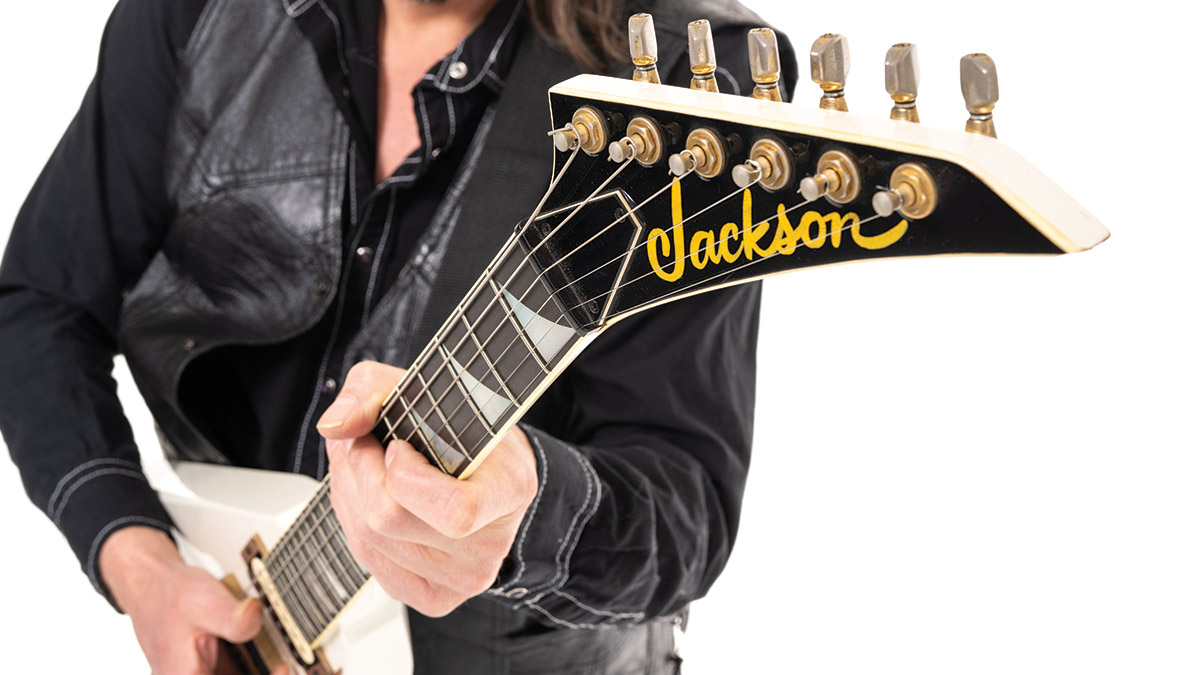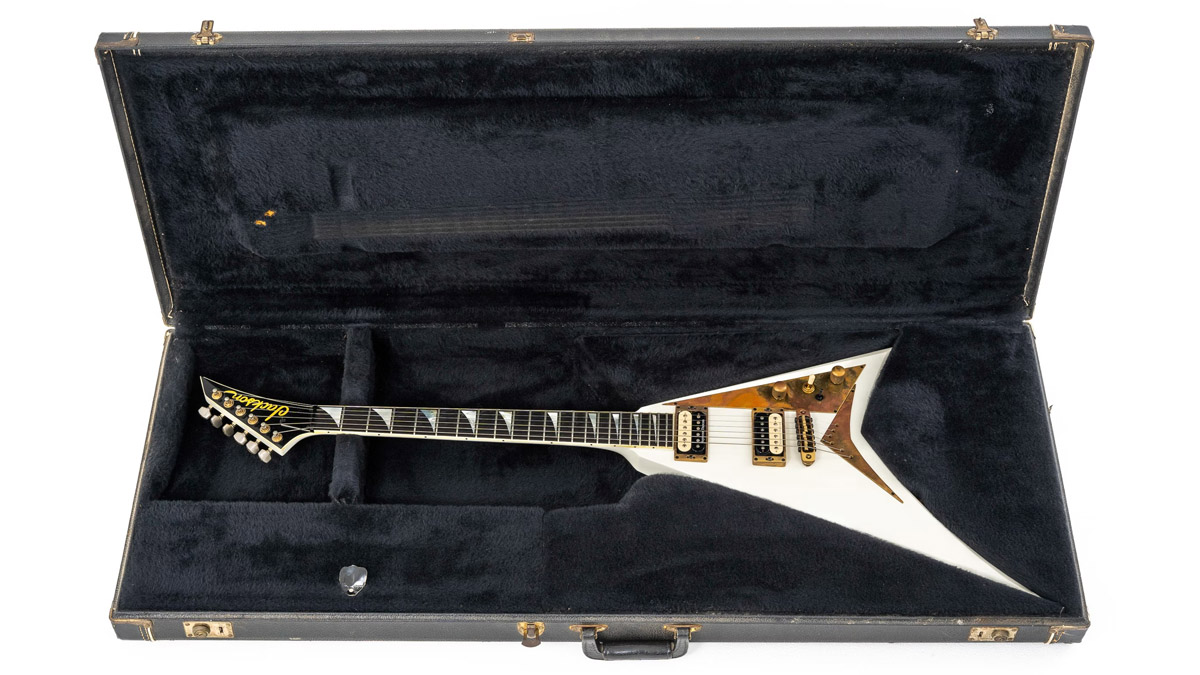The story of Randy Rhoads’ long-lost Jackson RR3 prototype – and why it is now going up for auction
Built for the late Ozzy Osbourne guitarist in 1982, only to be completed after his death, the prototype RR3 presents the metal guitar and the Jackson brand at a crucial stage of their evolution, and now its owner, Sean Michael Clegg, is putting it up for sale

Back in 2007, I wrote an article for Guitar World on an instrument that holds a special and unique place in the six-string legacy of Randy Rhoads.
Now reverently known as RR3, it was the third custom, asymmetrical V-shape electric guitar made for Rhoads by California luthier Grover Jackson in the early Eighties. Sadly, Rhoads died – in a March 19, 1982, airplane accident while on tour with Ozzy Osbourne – before he could take delivery of the guitar.
Instead, the ax ended up in the hands of one of Randy’s biggest fans, SoCal guitar ace Sean Michael Clegg. For the next 35 years, Clegg played the guitar on session dates and on gigs and studio recordings with his prog-metal band, Accomplice.
He has fond memories of being onstage with the guitar when Accomplice opened for rock legends like Rush and Van Halen.
But now, financial challenges have compelled Clegg to sell his beloved and historic guitar. Parting with a treasured instrument is always tough for a musician. But Clegg is stoic about the situation.
“I suppose I always knew this guitar was an incredible investment,” he says. “And it still will be for someone else. It’s a lucky miracle that I can lean on the sale of this guitar when I need it the most. And, believe me, it’s worth every penny of investment for the future.
“The RR Jackson is the coolest-looking stage guitar I’ve ever owned, delivering a tone and playability that are unmatched. It is by far the best-playing guitar I’ve ever owned, and it’s been a true privilege shredding on it for all these years. I am thankful for my time with it.”
Get The Pick Newsletter
All the latest guitar news, interviews, lessons, reviews, deals and more, direct to your inbox!
The guitar is being auctioned through ANALOGr, and – as of this writing – Clegg is also in direct contact with a few interested buyers.

“We estimate the value to be around $100,000 to $150,000,” he says. “The auction could bring a higher price. Right now we are certainly considering any six-figure offer [the current highest bid is $147,329.45]. The guitar is a dream and should go into the hands of a real player. Right now we have a couple of rock stars – who shall remain nameless – who have expressed interest. Whoever ends up with this guitar will be a lucky individual.”
A bizarre series of lucky circumstances played a role in Clegg’s acquisition of the instrument. Grover Jackson had built two previous prototypes for Rhoads – known as RR1 and RR2 – tweaking the design as Randy tested the instrument on the road with Osbourne and reported back to Jackson with design input. Jackson also cut the basic parts for a third guitar but didn’t assemble them. He was waiting for Rhoads to come off tour to provide his final feedback on the design.
But, of course, Randy did not return from the tour. Grief-stricken, Jackson put away the unfinished pieces of the third guitar. There they lay until late 1983. At that time, the luthier had split off from Charvel to form his own company, Jackson Guitars.
The guitar is a dream and should go into the hands of a real player
For the company’s debut at the Winter NAMM Show in January 1984, Jackson assembled and completed the third Rhoads guitar, intending to use it as a display piece at the Anaheim, California, expo. Jackson was a hot new brand in those halcyon days of poodle cuts and spandex.
The company’s NAMM booth was mobbed. In the excitement and confusion, a hapless assistant made a major error: he sold the guitar to a NAMM attendee, not realizing that it was a one-of-a-kind prototype that Rhoads himself had helped to design – a piece of heavy metal history.
“A few hours later, Grover’s going, ‘Where’s Randy’s guitar. Where’s Randy’s guitar?’” Clegg told me in ’07 [see the April 2007 issue], recounting the story as he’d heard it from Jackson himself. “Grover had a total, freak-out panic attack.”
The purchaser was a guy named Mike, whose surname has been lost to history. Apparently, Mike didn’t know what he had. A few months after the NAMM Show, he traded the guitar to a music store in Long Beach, California, for some far more ordinary gear.
I felt like the Lord had brought me a magic sword to fulfill my destiny
Young Sean Clegg was working in the shop as a guitar teacher, valued for his knowledge of Randy Rhoads riffs. When Mike presented the guitar, Clegg’s eyes popped out of his head. He immediately knew he had to own it
“I felt like the Lord had brought me a magic sword to fulfill my destiny,” he says. “We gave the guy a Neal Schon model Aria Pro II guitar, a Roland Jazz Chorus amp, some cords and whatever other small accessories he wanted in exchange for the Randy guitar. It added up to a couple thousand dollars retail.”
This was, however, more than Clegg could afford at the time. Fortunately his employer was looking out for him.
“I was 17, and my boss was sort of a father figure and mentor to me. He and my mother pitched in and helped me get the guitar.” Clegg’s boss let him work off his repayment, and the young guitarist saved up to pay back his mother. Within a year, Clegg had repaid his debts and was putting the guitar to use regularly.
RR3 is truly a one-of-a kind instrument that differs from stock Rhoads models and from the other prototypes Jackson built for Rhoads. Most noticeably, RR3 boasts a Gibson-style stop tailpiece rather than the tremolo tailpiece featured on stock models.
The strings pass through the neck-thru body and are drawn over the bridge at a sharp angle, which enhances sustain. The headstock – in the “hockey stick” shape so iconic to Eighties metal – has a severe tilt, which also adds to the instrument’s sustaining properties. This is such an early prototype that the Jackson logo on the headstock was hand-drawn by Grover himself.
“There were no decals or anything,” Clegg says. “And, of course, there’s no serial number on the guitar.” The hardware is one-of-a-kind as well.
“All the Jacksons you see in production have a lot of plastic on them,” Clegg said in ’07: “Plastic knobs, plastic pickguard.... But on this guitar, the pickguard and everything else is solid brass. Grover told me he had a metal worker somewhere in Fullerton [California] cut it by hand.”
Randy Rhoads’ original concept for the guitar that would forever bear his name was based on the Concorde supersonic passenger aircraft – an asymmetrical version of the classic Gibson Flying V body shape, with the upper body bout significantly larger than the lower one and much sharper angles all around.
The design would become a milestone in the evolution of the heavy metal “pointy guitar” aesthetic. It was originally slated to be called the Jackson Concorde, but after Rhoads’ passing it became the Randy Rhoads model.

RR3 is an integral part of that legacy – a missing link, if you will, between earlier prototypes and the production models that have sold in vast quantities. It’s a slab of metal history that also happens to be an eminently playable, finely crafted musical instrument.
“It wants to be played,” Clegg says. “Whatever you have to offer musically, it will deliver for you on the other end 100 percent. It’s one of the first true shred guitars, and in my humble opinion, one of the best playing guitars ever made. An instrument truly made for a virtuoso.”
- For more details on the auction of the Jackson RR3 Protoype, head over to ANALOGr.
In a career that spans five decades, Alan di Perna has written for pretty much every magazine in the world with the word “guitar” in its title, as well as other prestigious outlets such as Rolling Stone, Billboard, Creem, Player, Classic Rock, Musician, Future Music, Keyboard, grammy.com and reverb.com. He is author of Guitar Masters: Intimate Portraits, Green Day: The Ultimate Unauthorized History and co-author of Play It Loud: An Epic History of the Sound Style and Revolution of the Electric Guitar. The latter became the inspiration for the Metropolitan Museum of Art/Rock and Roll Hall of Fame exhibition “Play It Loud: Instruments of Rock and Roll.” As a professional guitarist/keyboardist/multi-instrumentalist, Alan has worked with recording artists Brianna Lea Pruett, Fawn Wood, Brenda McMorrow, Sat Kartar and Shox Lumania.
“Even the thought that Clapton might have seen a few seconds of my video feels surreal. But I’m truly honored”: Eric Clapton names Japanese neo-soul guitarist as one to watch
“You better be ready to prove it’s something you can do”: Giacomo Turra got exposed – but real guitar virtuosos are being wrongly accused of fakery, too















